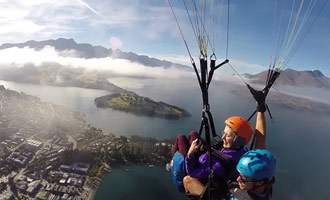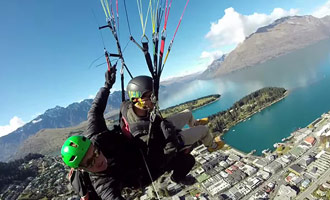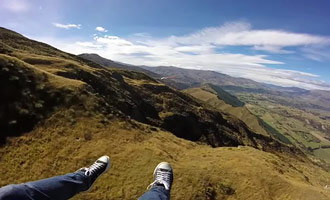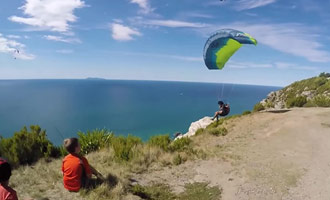
The Best of Paragliding in New Zealand.
Please contact us and we will help you to organize your trip! It's free and without commitment.
- Read the post
- Details
- Advices
The Practical Guide of the Activity.
- 1Thrills at a Reasonable Price With Paragliding.
- 2Should You Fear the Take-Off?
- 3How Does a Paragliding Tandem Flight Takes Place?
- 4Does Paragliding Involve Risks?
- 5What Budget for a Paragliding Tandem Baptism?
- 6Where to Go Paragliding in New Zealand?
- 7Where Can I Get Paragliding lessons?
- 8Is Paragliding a Must-Do in New Zealand?
Thrills at a Reasonable Price With Paragliding.
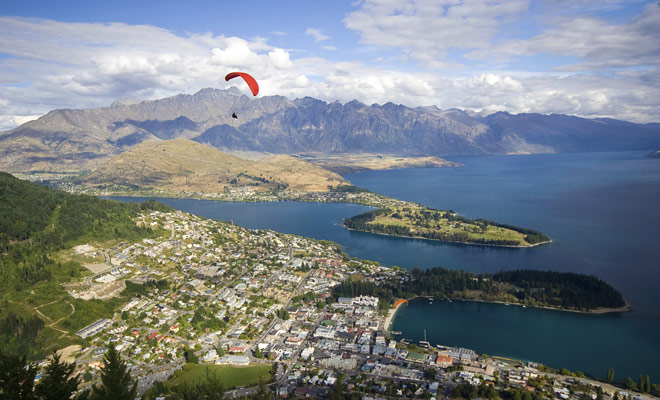
The paragliding allows to fly over dream landscapes.
Do we really need to highlight again the beauty of the landscapes of New Zealand seen from the sky? The photos speak for themselves but cannot reproduce the sensations of a paragliding flight over a turquoise lake surrounded by snow-capped peaks.
Paragliding as it is practiced in New Zealand consists of taking off a mountain and allowing yourself to be carried by a sail.
The activity is mainly practiced in tandem: a professional instructor ensures the maneuver while the passenger quietly enjoys the breath-taking scenery.
In a country that offers countless activities overpriced, paragliding remains a sport accessible to small budgets.
For example, a baptism of paragliding at $200 costs half the price of a parachute jump, and for a double duration-time!
As the majority of travelers will discover the country of the kiwis during a brief stay, this guide is mainly devoted to the paragliding baptisms to be carried out in tandem.
But it is also possible to take lessons to learn to fly all alone if you want...
True to its reputation of World Capital of Adventure, the city of Queenstown is considered the Mecca of paragliding in New Zealand. It was here where the first amateur flights took place in the 80s, but the very contrasted relief of the country offers countless flying spots!
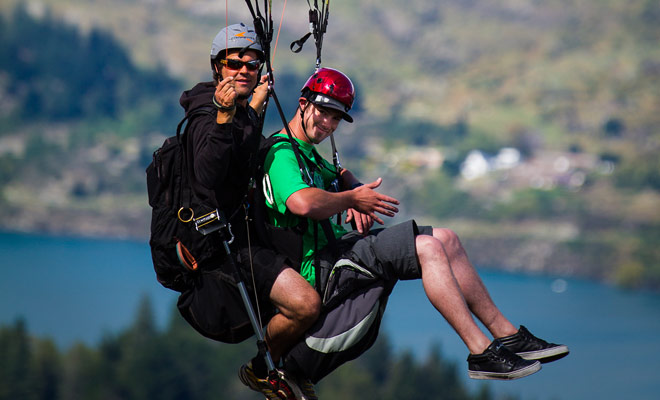
The paraglider monitor takes care of the entire maneuver.
I will present the complete activity, from take-off to landing, going through the list of the best organizers and the most beautiful spots.
Security issues will not be neglected and I will reassure those who still hesitate.
Should You Fear the Take-Off?
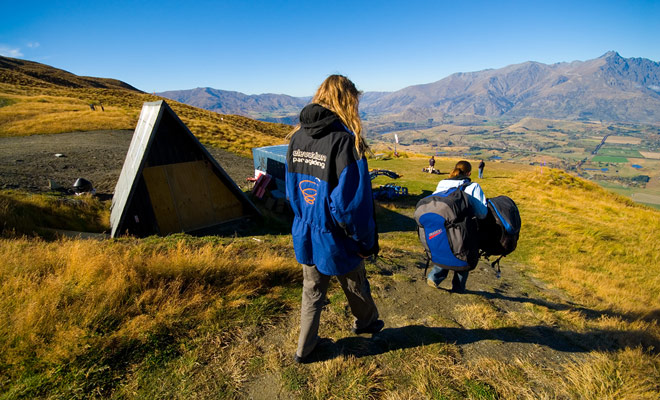
Take-off always takes place on the side of a mountain.
Access to the take-off track is conducted by the organizer who will come pick you up at your hotel or at the nearest i-Site. Allow one to two hours of free time to get to meet your instructor and equip yourself.
About clothes, a pair of sneakers, a jeans and a good hot sweater should do the trick. But I recommend that you ask the question directly by phone to the organizer, because the air is often cool in the mountains (including in summer): so avoid being caught off guard once in the air!
Do not forget your sunglasses, an indispensable accessory when you will fly over snowy landscapes and lakes with high reverberation.
The rest of the equipment (helmet ...) is provided before take-off.
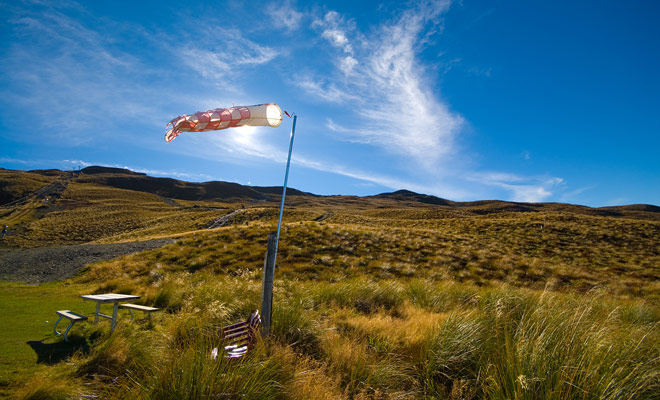
It takes a minimum of wind to make the take-off possible.
The practice of paragliding depends mainly on the weather conditions.
To be able to take off, the presence of a slight rising wind facilitates the operations, especially in tandem.
Sometimes you have to wait half an hour for optimal weather conditions.
The instructor takes advantage of the waiting to detail the procedure to follow during take-off and landing phases. He will also present the flight plan and if you still have some fears, do not hesitate to share them.
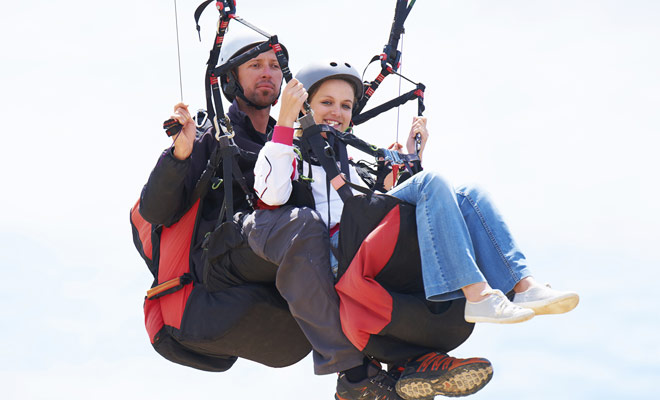
You will be comfortably installed throughout the flight.
It is quite normal to feel a little apprehension before a paragliding baptism, but the monitor is here to reassure you. Of course, you are not going to jump from of a steep cliff, and the take-off is done with disconcerting ease.
Beginners apprehend take-off, but this is a very easy step.
When the time comes, you will run down a slope with the wing spread to the ground behind you in the axis of the wind. Of course, you're not going to rush to a steep cliff, and the take off is done with a disconcerting ease.
How Does a Paragliding Tandem Flight Takes Place?
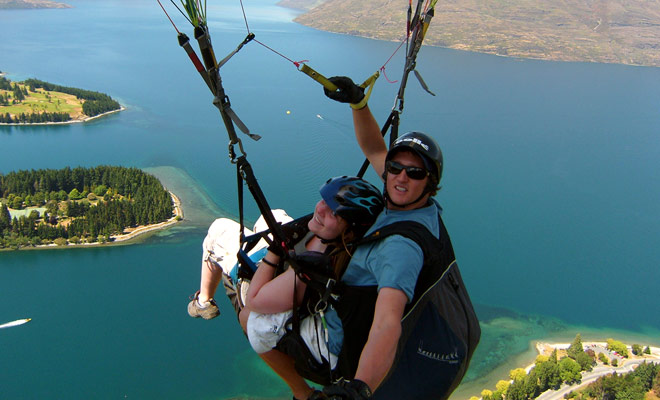
Tandem paragliding is safe.
When you try paragliding, the smooth take-off surprises the first time. It seems perfectly natural, with nothing in common with the adrenaline rushes you can experiment during skydiving or bungee jumping.
A few seconds after leaving the ground, you will be seated comfortably and the monitor will take care of all the maneuvers. By reflexes, you will cling to the fasteners before realizing that it is not necessary.
The wing that carries you is composed wing a large number of interconnected cells where the wind blows to give it a characteristic shape in a circular arc.
If it is not as fast as hang-gliding, paragliding allows to move at a speed between 25 and 38 hm / h.
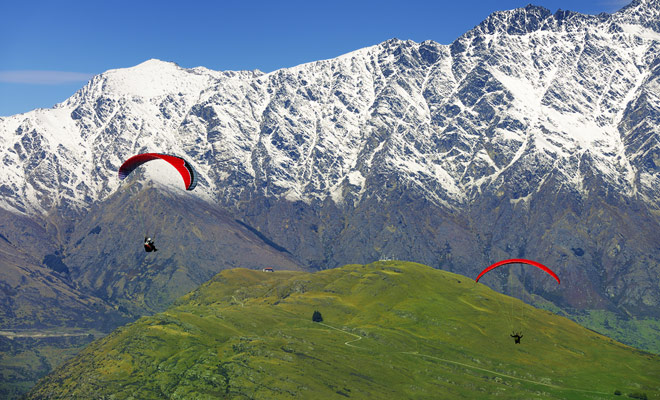
Modern paragliding has improved considerably.
If the weather conditions are good, the monitor will let you even perform some simple maneuvers, such as changes of direction, but nothing forces you to do so.
Always with your approval, you can experience some thrills by performing 360 ° turns and sudden accelerated descents.
Landing is easy as the monitor takes care of everything!
Landing is often feared by beginners, but this maneuver presents no difficulty in tandem. The operation is carried out following a trajectory facing the wind. The monitor takes care of everything and will only ask you to fold your legs before landing.
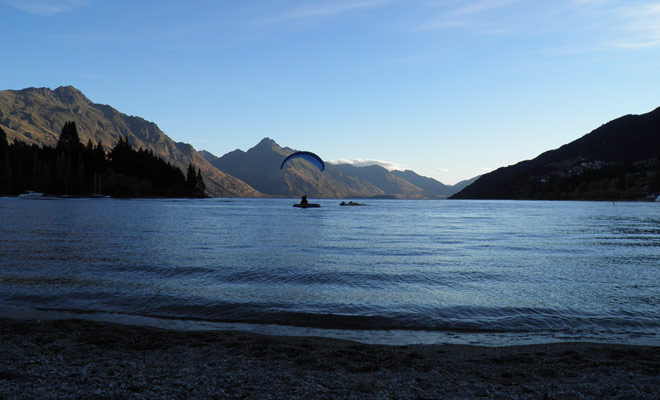
The pro of the paraglider are able to land precisely.
When the time comes, you will land in a field, after a peaceful descending to the vertical. For spectators, this seems like a child's play at first glance, but is paragliding a safe sport?
Does Paragliding Involve Risks?
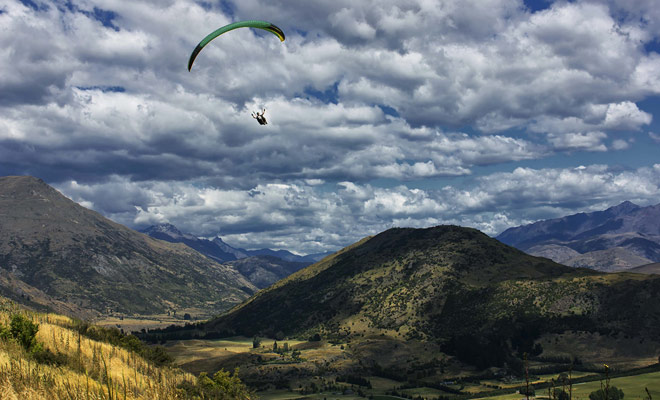
Tandem accidents are extremely rare in tandem.
Paragliders who draw perfect lines in the air incline us to think that the activity involves no risk. Danger exists, of course, but accidents are mainly attributable to piloting errors committed by beginners flying all alone. The material is hardly ever involved.
During tandem flights, the instructor keeps clear of the cliffs without taking any risks.
As a passenger, you will be securely harnessed and the emergency parachute is mandatory and provides a double safety.
The professionals perform the take-off and landing phases with exceptional precision.
Each pilot trains every day to be able to control his speed, the direction of his sail and, of course, the altitude of the flight.
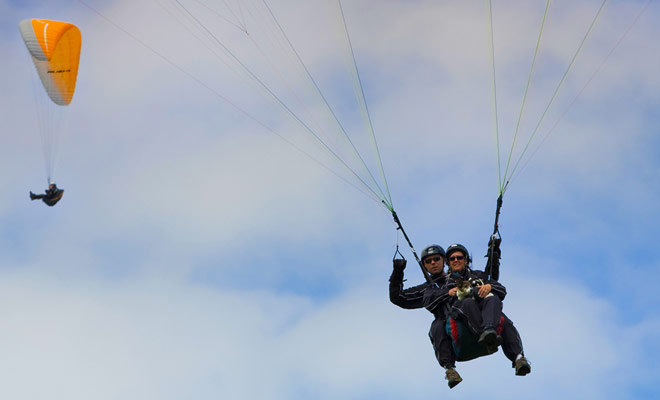
Paragliding instructors have thousands of hours of flying time.
Nothing is left to chance: instruments (altimeter and variometer) allows the monitor to know exactly how fast his sail goes up or down in the air. In reality, the landing is almost always done in the same location, sometimes within a few meters. Because a monitor never takes-off without knowing in advance where he plans to land, and he follows a route taken hundreds of times before.
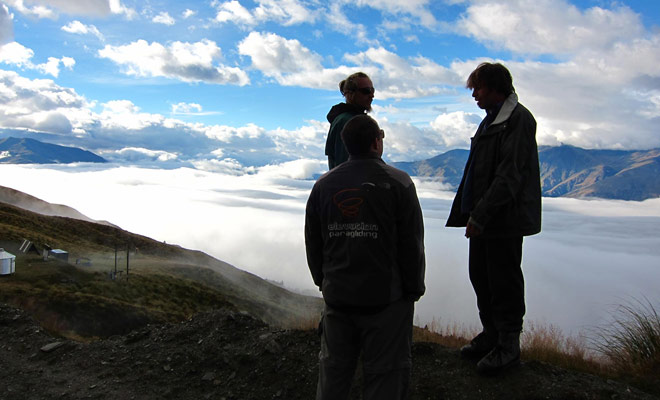
The flight will be delayed if the weather is not favorable.
Even if this is a tourist activity, the security conditions are never taken lightly.
Weather plays an essential role, and unstable conditions such as a strong wind or rain are enough to postpone an outing.
The number of serious accidents concerns a derisory percentage (0.026% of flights each year).
In these conditions, your only concern should be to know if you have the means to offer yourself a paragliding baptism in tandem ...
What Budget for a Paragliding Tandem Baptism?
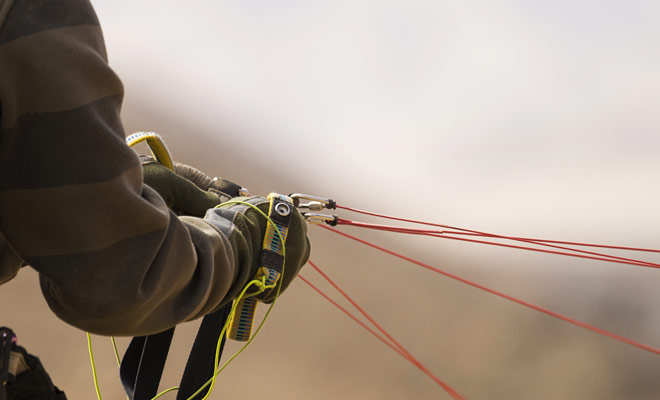
Paragliding is an expensive, but unavoidable activity.
Difficult to resist the urge to try paragliding when visiting Queenstown, Wanaka or Nelson. Even people who suffer from a slight dizziness often want to book a flight when they realize how beautiful the panoramas are in New Zealand!
The average tariff for a baptism of paragliding in tandem oscillates between $180 and $200.
In addition, it usually costs $30 to $50 to get souvenirs pictures or videos on a USB key. This is a nice extra, but you will be able to control the quality before you buy anyway.
Paragliding is considered an extraordinary activity by more than 95% of people who tried it in New Zealand (source Trip Advisor).
You will get what you pay for, with thrills and unforgettable memories.

The satisfaction rate of paragliding baptisms is 95%!
And since the activity does not require exceptional courage (the monitor performs all the maneuvers), it's not always easy to find an available time slot! Paragliding is a victim of its success and it is imperative to book, if only to benefit from significant reductions (sometimes up to -10%).
I recommend booking the first flight of the day.
In the early morning, the weather is often better and prices are sometimes lowered. This does not change the duration of the flight which varies from 7 to 20 minutes depending on the strength of the wind, but especially according to the quality of the monitor ...
Where to Go Paragliding in New Zealand?
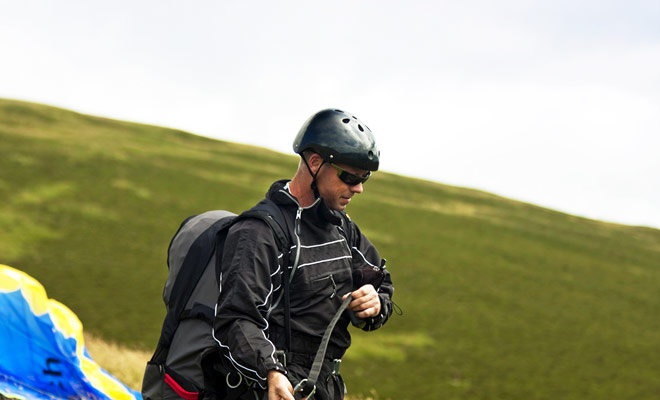
Paragliding can be practiced on both islands of the country.
Here is Kiwipal’s selection of the top five paragliding organizers in New Zealand. Our strict criteria are based on the company's history, professionalism and service quality.
Gforce Paragliding (Queenstown)
The GForce Company has two take-off areas located behind the Queenstown Skyline Complex that overlooks Wakatipu Lake.
You will have to use the gondola to reach your instructor, but the tickets are fortunately included in the price.
| Period | Rate |
|---|---|
| During day time (normal rate) | $199 |
| Morning (reduced price) | $179 |
Bookings on the GForce website
Coronet Peak Tandem (Queenstown)
Coronet Peak is the highest paragliding spot of the Otago, at only twenty minutes of Queenstown. The take-off is a little more impressive than usual, but presents no difficulty.
| Period | Rate |
|---|---|
| During day time (normal rate) | $195 |
Bookings on the site of Tandem Paragliding
Wanaka Paragliding (Wanaka, South Island)
The company's departure point is at the Treble Cone ski resort. Perhaps the most beautiful panorama of the whole country, with a flight slightly longer than the average (from 15 to 25 minutes).
| Period | Rate |
|---|---|
| During day time (normal rate) | $199 |
Bookings on the site of Wanaka Paragliding
Nelson Paragliding (Nelson, South Island)
A take-off based in Barnicoat Hill, a great spot well known to the locals, but underestimated by the general public. Make no mistake, the area is perfectly suited for paragliding and the panoramas have nothing to envy those of the Otago.
| Period | Rate |
|---|---|
| During day time (normal rate) | $180 |
Bookings on the Nelson Paragliding website
Wings and Waves(North Island)
The Auckland area offers countless points of flight, but the most famous is Muriwai Beach Cliffs, where Wings & Waves proposes to take off from the top of the cliffs.
For enthusiasts who cannot be satisfied with just a single short flight during their stay, here is a list of the best spots to practice the paragliding on the two islands of New Zealand.
Contrary to what our previous ranking might suggest, the North Island has even more paragliding spots than the South Island.
| Period | Rate |
|---|---|
| During day time (normal rate) | $210 |
Bookings on the Wings and Waves website
Where Can I Get Paragliding lessons?
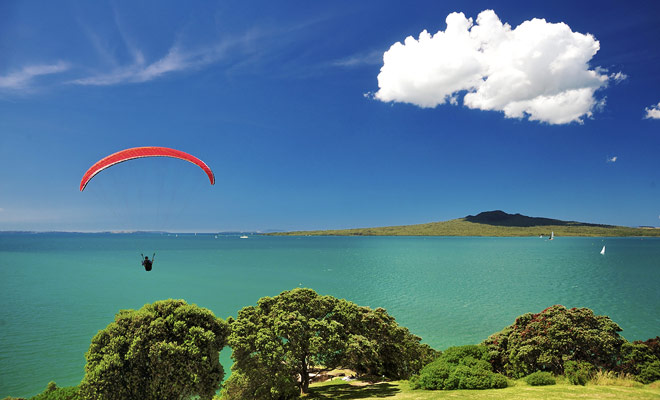
Paragliding is a very popular sport in New Zealand.
For those who have more time to spend in New Zealand (for example travelers with a Working Holiday Visa), it is possible to search for less tourist spots.
Here is a list of locations where paragliding is practiced away from crowds of tourists. If you want to improve your level or take lessons, you will pay less and spend more time in the air.
| Location | Island | Spot |
|---|---|---|
| Auckland | North Island | Dills Hill |
| Auckland | North Island | Karioitahi |
| Auckland | North Island | Mangawhai heads |
| Auckland | North Island | Moirs hill |
| Auckland | North Island | Muriwai |
| Auckland | North Island | Piha |
| Hawke's bay | North Island | Burma road |
| Hawke's bay | North Island | Ocean beach |
| Hawke's bay | North Island | Te mata peak |
| Bay of Plenty | North Island | Kaimai range |
| Bay of Plenty | North Island | Ohiwa |
| Bay of Plenty | North Island | Ohope |
| Bay of Plenty | North Island | Paeroa range |
| Tauranga | North Island | Mt Maunganui |
| Taranaki | North Island | Mokau |
| Waikato | North Island | Port waikato |
| Waikato | North Island | Raglan |
| Wellington | North Island | Pukerua bay |
| Wellington | North Island | Paekakariki hill |
| Canterbury | South Island | Castle rock |
| Canterbury | South Island | Craigieburn |
| Canterbury | South Island | Taylors mistake |
| Queenstown | South Island | Coronet peak |
| Wanaka | South Island | Treble cone |
| Wanaka | South Island | Cardrona |
| Wanaka | South Island | Crown range |
| Nelson | South Island | Takaka hill |
| Nelson | South Island | Tapawera |
Is Paragliding a Must-Do in New Zealand?
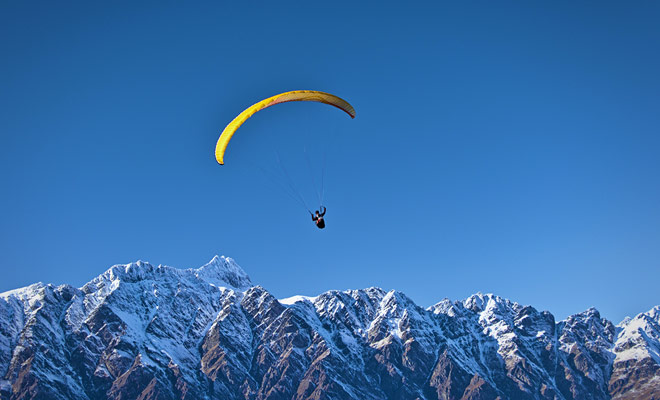
New Zealand is perfect for a paragliding baptism.
New Zealand is undoubtedly one of the most beautiful countries in the world to practice paragliding, thanks to a mountainous terrain that offers countless incredible spots. For some beginners, paragliding is a real revelation and if you are among them, you can decide to take lessons to learn to fly all alone.
If solo paragliding is sometimes categorized as an extreme sport, a tandem excursion with a monitor is practically a leisure activity open to everyone. Even children over the age of seven can live a dream awake, and seniors are accepted without age limits.

Weather conditions are ideal for paragliding.
A regular question about paragliding concerns the time spent in the air: on average, you can expect to spend 15 minutes flying over extraordinary landscapes, but the weather can lengthen or shorten the flight. The activity does not come free, but the paragliding deserves some sacrifices.
We have just scratched the surface and I hope to have given you the desire to try such an exceptional activity.
Do not ask yourself too many questions, and book your flight on the Internet without delay: online rates are generally 10% cheaper than on location.
I leave you with our friend Ben the Kiwi, our paragliding expert.
If you have any questions, just ask and you'll receive a quick reply.


Questions & Answers.

What can I do for you? I guess you have questions about paragliding! But there's no need to worry because tandem flight is child's play. If there are any details to clarify, I will be happy to help you.
- All topics ... 7 answers in total
- Booking a Paragliding Activity 4 answers
- Safety Instructions 2 answers
- Paragliding 1 answer
Booking a Paragliding Activity
- What is the requested weight for paragliding?
The participant must weigh between 20 and 120 kg.
- Is paragliding open to children?
Parental consent is mandatory for minors and the age requirement varies according to the organizers.
- What are the cancellation terms?
They are specific to each organizer (read the general conditions of sale). In general, you will be fully reimbursed if weather conditions do not allow you to organize an outing, and if you do not agree to postpone the activity to another day.
- Can one film the flight by his own means?
You are usually allowed to bring your own camera, or a GoPro camera.
Safety Instructions
- Can you practice paragliding if you suffer from vertigo?
You must have your feet on the ground to suffer from vertigo. Therefore, you will not suffer from vertigo by performing a paragliding flight. One must, however, distinguish the vertigo that is related to the inner ear, and fear which is a psychological mechanism.
- Can we crash when landing?
The chances for your monitor to miss a landing he has practiced hundreds of times in the same place are almost nil. Of course, zero risk does not exist, but you will not even be in charge of the maneuver.
Paragliding
- What is the world record for a paragliding flight?
The record of distance traveled in New Zealand is 147km! The flight can theoretically extend indefinitely, but one must remain reasonable.

